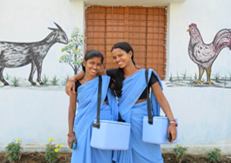

Context
The Pashu sakhi initiative of the Jharkhand government which was started in 2013, for last mile coverage of livestock management has shown successful ground results and is seen to be implemented in other rural areas.
About
About the initiative:
- Aim:To advise farmers about health check-ups for their livestock, vaccinations, de-worming, hygiene, breeding, feeding, and the management of animal waste.
- The project was conceived under the National Rural Livelihood Mission, with the objective of building a line of community resource persons.
- Pashu Sakhi, which means ‘friends of animals, is a woman from the village trained to handle routine medical requirements for animals, including cows, buffaloes, bulls, poultry and goats.
- While they are not trained to handle surgical interventions, they can identify diseases, provide medication, and vaccinations, and suggest remedial or preventive actions.
- Pashu Sakhi is a Community Animal care Service Provider (CASP)this will enable the last mile coverage in rural areas where clinical services for livestock are not available on time or expensive to afford for the rural poor.
Fund allocation: In 2017-18, the Jharkhand Opportunities for Harnessing Rural Growth (JOHAR) took the project under its wing and the World Bank began funding it.
|
A World Bank newsletter said that the pashu sakhi model under JOHAR had been selected by the UN’s Food and Agriculture Organization and the International Food Policy Research Institute as one of the top eight global best practice models for farmer service delivery |
Objective:
- The objective of this model is to make livestock-based livelihoods sustainable and viable enterprises for the rural poor.
- There will be a specific focus on the ultra-poor householdswho have limited or no access to land or other factors of production.
- It would build a strong extension network of livestock workers who are community-based practitioners and are accountable to community institutions.
- The model would aim at strengthening the existing livelihoods of the rural poor by bringing a clear impetus to livestock-related activities.
Need of the initiative:
- Jharkhand’s livestock production is in the hands of marginal and landless farmers, with women accounting for over 70% of the production. In fact, many of the pashu sakhisown livestock themselves.
Key features:
- The pashu sakhisare put through a three-level (introductory, practical, and upper) 30-day trainingprogramme over seven-day tranches on how to take care of poultry, goats, and pigs.
- After the training, they provide technical expertiseon taking care of livestock, advise fellow villagers on the economic benefits of rearing livestock for sale, and connect farmers to producer groups and traders, helping them get better access to markets to sell their produce.
- About 30 pashu sakhi have also been trained with 45 days of additional training in livestock management.
- They will act as a medium of the interface between the Animal Husbandry & Veterinary Departmentand the rural poor by linking the HHS to the nearest Veterinary aid centre at the time of need.
Significance:
- The pashu sakhisor doctor didisof Jharkhand have contributed to achieving the mortality rate of goats which has come down by about 30% and of poultry by 40%.
- It tends to develop livelihood options among the village women and respect among the villagers.
- The initiative has included livestock rearing awareness across the tribal communities and makes them independent.

